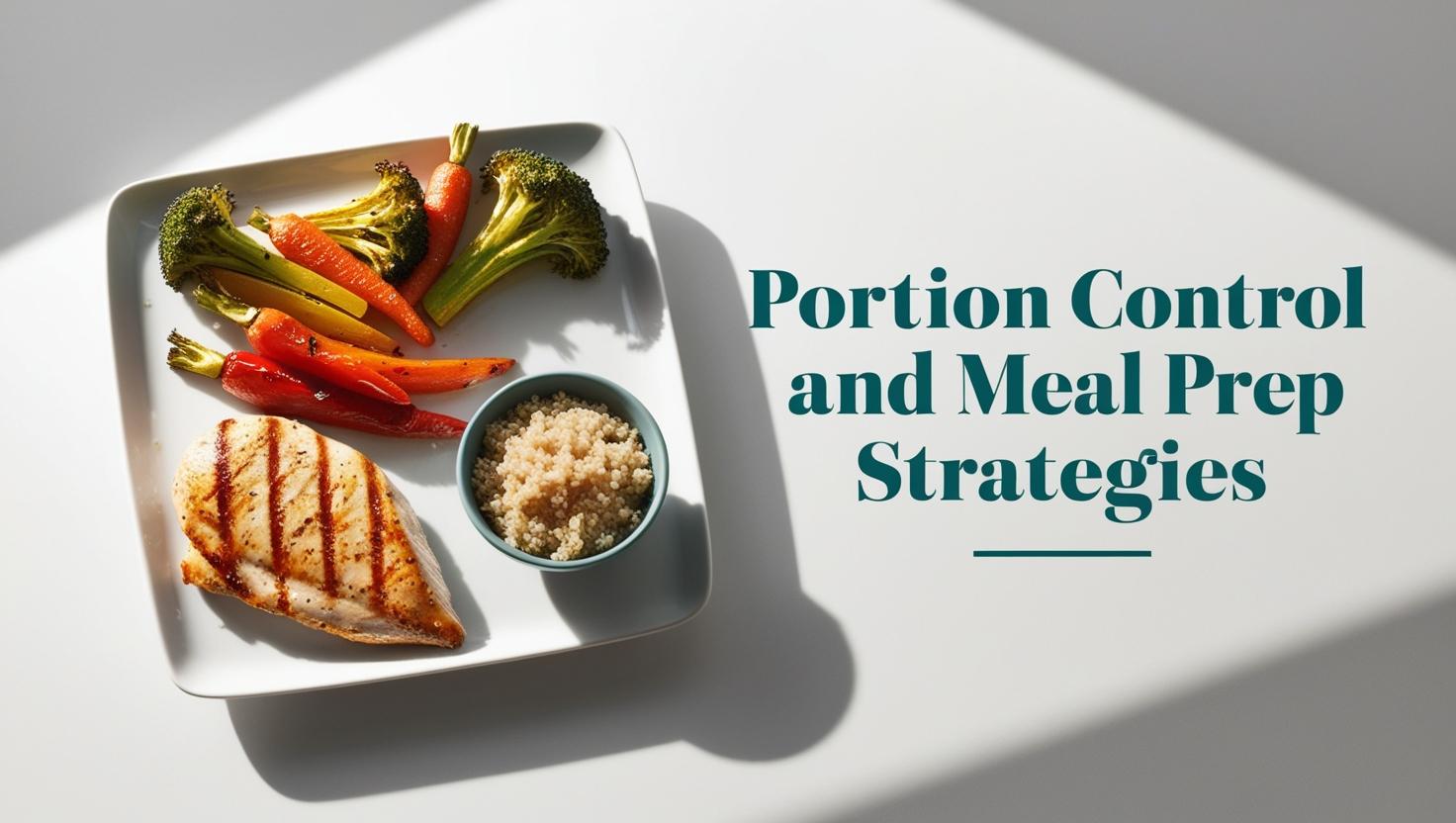Portion Control and Meal Prep Strategies
Did you know larger portions make us eat 25-40% more, even when we’re not hungry? This fact shows how crucial portion control is for our eating habits. With obesity rates going up, using mindful eating and meal prep strategies is very important.
Portion sizes don’t just affect how much we eat. They also play a big part in our overall weight management goals and eating habits. By knowing and managing portion sizes better, we can improve our health and fight obesity.
Understanding the Importance of Portion Control
Portion control is key to shaping how we eat. Many Americans suffer from “portion distortion.” They think one serving is actually much smaller than it is. This leads to eating too much and, often, to obesity. Even with plans like the DASH Eating Plan, sticking to the right sizes is hard.
How Portion Sizes Impact Eating Habits
People tend to eat about 30% more when given bigger plates or bowls. Research shows this extra food can mess up even good eating habits. The DASH Eating Plan recommends:
- 6-8 servings of grains for a 2,000 calorie diet.
- A maximum of 6 servings for meats, poultry, and fish.
- 4-5 servings of vegetables daily.
- 4-5 servings of fruits each day.
- 2-3 servings of low-fat or fat-free dairy products.
- 2-3 servings of fats and oils.
- Weekly servings of nuts, seeds, and dry beans at 4-5.
- Limit sweets to no more than 5 servings weekly.
Such guidelines teach us to be mindful of what we eat. Knowing portion sizes, like comparing them to everyday objects, helps control how much we eat.
The Relationship Between Portion Sizes and Obesity
The link between portion sizes and obesity is important to understand. Many don’t know what a proper serving size looks like. For instance, a serving of meat or poultry should be as big as a deck of cards. Yet, many people eat more than this. A medium apple has about 60 calories, and veggies like a medium tomato have only about 25 calories. Knowing how to measure food can help us eat fewer calories.
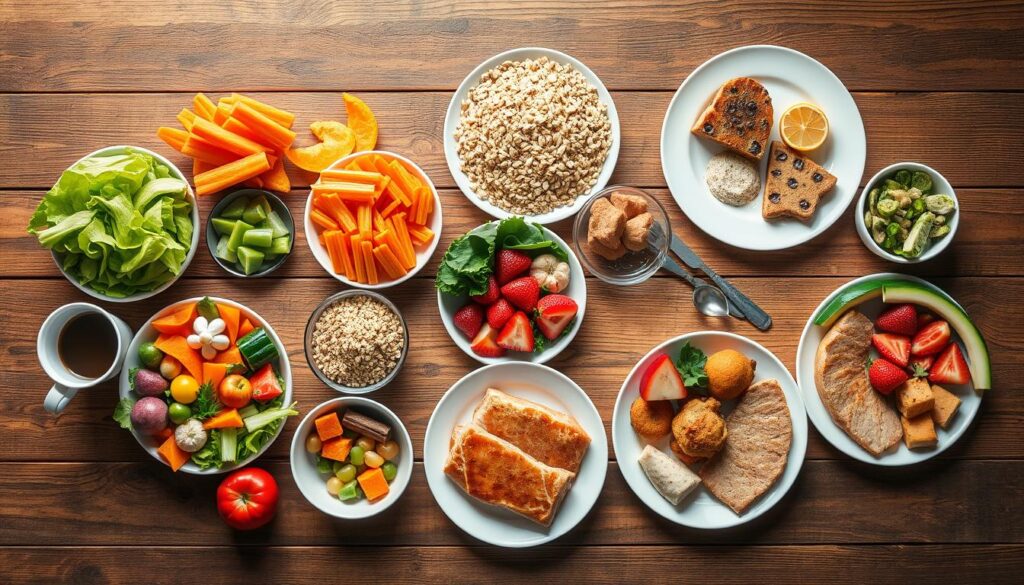
By eating mindfully and controlling portions, we can fight obesity more effectively. The role of portion control in healthy eating is crucial for lasting health.
Portion Control Techniques for Everyday Eating
Using smaller dinnerware can change how you eat every day. It makes your brain think you’re eating more than you are. Your choice of plates and bowls can really impact how you see portion sizes. Studies show that smaller plates help control how much you eat.
Your Plate as a Portion Guide
Think of your plate as a portion size guide. Try to fill half with veggies, a quarter with protein, and a quarter with grains. This helps you eat a balanced diet and stick to the right servings. For more details, check out a thorough portion size guide.
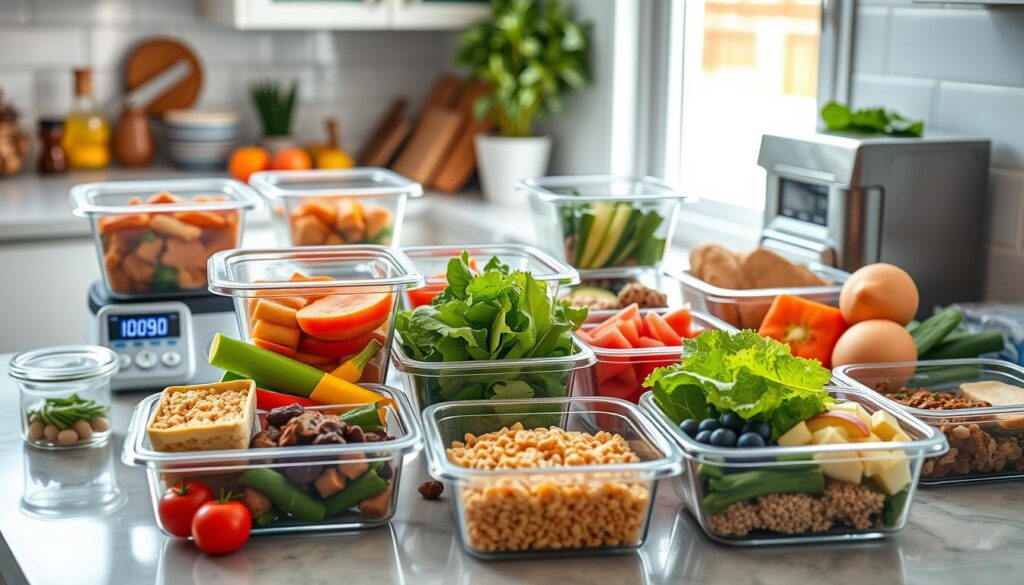
Be aware of how much you put on your plate. Restaurant servings are usually more than we need. Ask for smaller portions or share meals when eating out. Enjoy your food and let your brain catch up to feel full. Pause before getting more to keep portion sizes in check.
Practical Portion Control Tips
Understanding portion control is key to a healthy diet. It makes meals better by managing how much you eat. With simple tips, you can keep enjoying food while controlling your intake. This includes using common items for measurements and being smart about eating out.
Using Your Hands as a Measuring Guide
Your hands are an easy way to measure food without scales. Here’s a quick guide:
- Fist: Equals one cup of rice, pasta, or cereal.
- Palm: Matches the size of three ounces of meat or poultry.
- Two fingers (peace sign): Represents two ounces of cheese.
- Bent thumb joint: The same as one tablespoon of oil or peanut butter.
This method makes preparing meals easy. You serve right-sized portions without measuring cups. For more on serving sizes, visit this measuring guide.
Asking for Half Portions When Dining Out
Oversized meals in restaurants can mess with portion control. It’s smart to ask for half portions or split dishes. Many places will give you smaller servings if you ask. This way, you eat fewer calories and still enjoy your meal.
Another tip is choosing plates that contrast with your food. It makes you eat less. Focusing on your meal can also help you feel full. Next time you eat out, try these ideas. They make meals healthier and still fun.
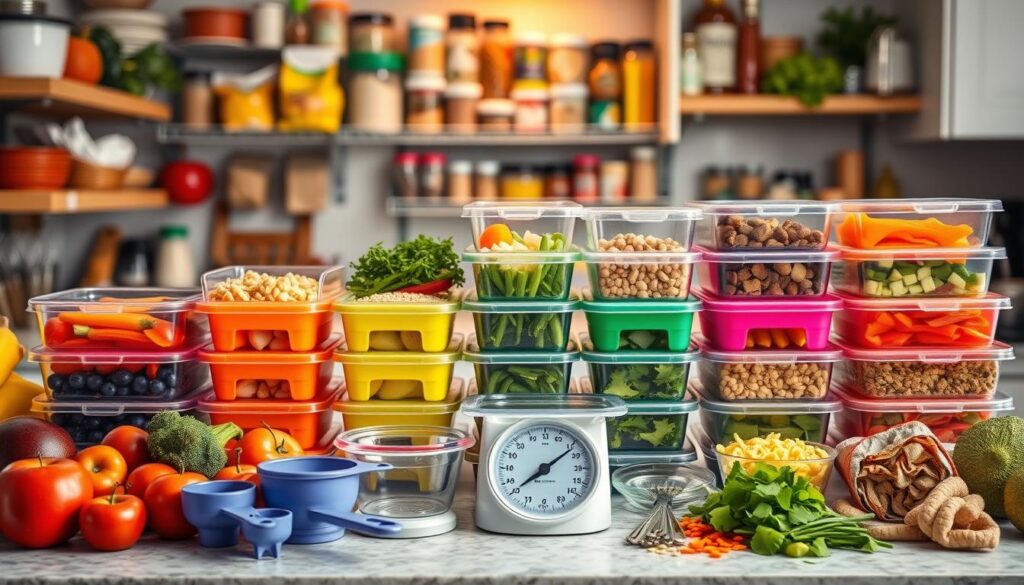
Mindful Eating and Portion Awareness
Mindful eating is a key part of living healthier. It helps people focus on their meals. This leads to knowing how much to eat and enjoying food more. Studies show that eating slower makes it easier to feel when you’re full. This helps prevent eating too much. By eating mindfully, you can improve your blood sugar levels and control your weight.
Taking Time to Eat Slowly
Eating slowly can greatly improve how much you eat. It lets us enjoy our food without overdoing it. Often, we eat too much because we’re distracted by things like TV or our phones. Mindful eating means really noticing the flavors and textures of our meals. This makes us feel more satisfied. Studies have found that eating quickly might make you eat more. Our brains need about 20 minutes to realize we’re full.
The Role of Hydration in Portion Control
Staying hydrated is vital for controlling how much you eat. Drinking water before meals can help control your appetite. It makes it easier to know if you’re really hungry or just thirsty. Keeping up with your water intake helps with eating the right amount of food. Drinking enough water also boosts your overall health. To learn more about the right portion sizes and mindful eating, visit this resource.
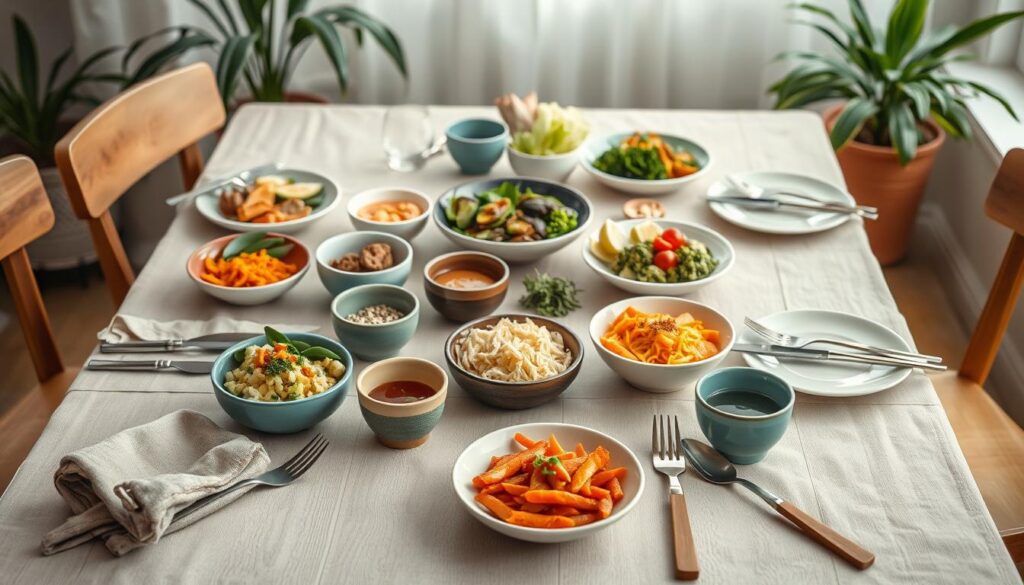
Effective Meal Prep Strategies for Weight Management
Meal prep is key to managing weight well. By planning meals ahead, you can skip unhealthy last-minute choices. The perks include saving both time and money. It also cuts down the daily hassle of deciding what to cook. So, picking a certain day for shopping and batch cooking is a smart move for anyone looking to manage their weight better.
Benefits of Meal Prepping
Meal prepping brings lots of benefits, especially for controlling weight. Let’s look at some benefits:
- Portion Control: Planning your meals helps you eat the right amount, which means eating fewer calories.
- Healthy Choices: Cooking at home lets you use fresh stuff, cutting down on processed foods.
- Cost-Effective: By cooking yourself, you’ll spend less, avoiding pricey takeout food.
- Time-Saving: Prepping ahead means less time cooking on busy nights.
- Flexibility: Having different meals ready boosts your diet’s quality by making it easy to mix things up.
How to Start Meal Prepping
To begin meal prepping, follow these steps:
- Select a prep day: Pick one day a week for shopping and cooking, and stick to it.
- Plan meals: Choose recipes that are easy to make in large batches and store well.
- Portion accordingly: Pack your meals in portions with 50% veggies, 25% protein, and 25% carbs.
- Storage: Keep cooked meals in the fridge to stay fresh; meat lasts 3-6 days.
- Track your meals: Use apps or journals to keep an eye on what you eat and stay on track.
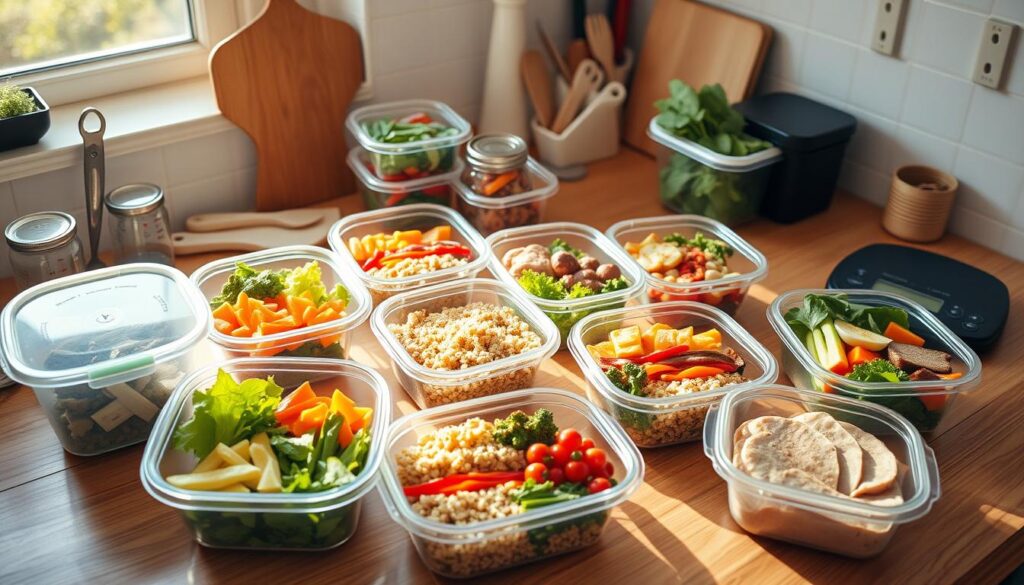
Utilizing Portion Control Tools
Using the right tools for portion control can change how we manage our meals. These tools help us plan meals better and keep up healthy eating habits. Portion control containers and measuring gear are top picks. They ensure our servings match our nutrition goals.
Using Portion Control Containers
Portion control containers vary in sizes and make meal prep easier. They can cut down calories by about 25% each meal. People find these tools keep them mindful of portions, which helps make healthy choices easier.
Research shows that 70% of people like how these containers help with meal planning. Also, 40% notice they waste less food, promoting sustainable eating practices.
Investing in Measuring Equipment
Kitchen scales and measuring cups are crucial for exact portion sizes. They prevent us from overestimating how much we eat, which helps control calorie intake. Studies have found that these tools can modestly help in weight loss, an important goal for many.
Investing in these tools not only makes meal preparation easier but also simplifies grocery shopping.
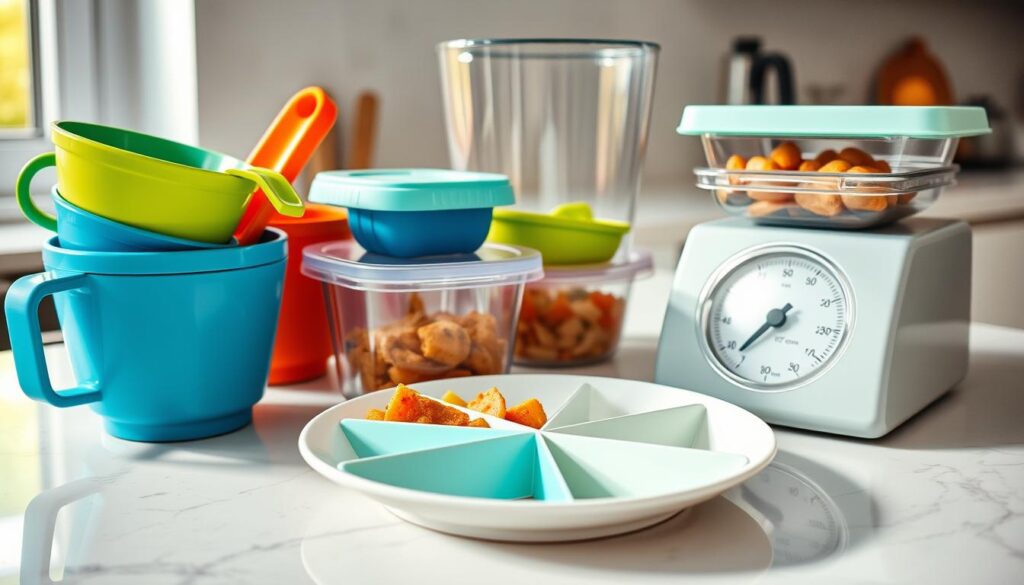
Meal Planning and Budgeting
Meal planning improves what you eat and helps control your spending. Making a grocery list for healthy items prevents buying on a whim. Doing this saves money and cuts down on wasting food.
Creating a Weekly Grocery List
It’s crucial to have a grocery list for effective meal planning. Shopping with a list stops you from spending too much or missing items you need. Some suggestions include:
- Focus on seasonal produce, which is often more affordable and tastes better.
- Take advantage of bulk buying to lower unit prices on essentials.
- Use coupons and consider store rewards programs to save even more.
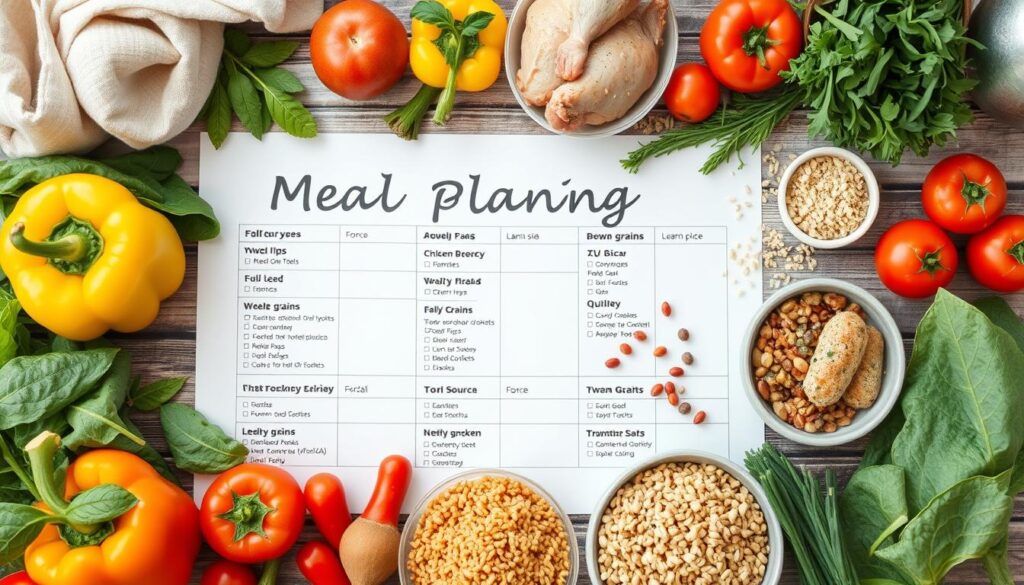
Shopping for Healthy Ingredients
Choosing healthy items is important for meal prep. Planning your food purchases leads to eating better overall. Consider these shopping tips:
- Stick to your grocery list to avoid impulse purchases.
- Engage your family in meal planning to create healthy habits that last.
- Explore local farmer’s markets for fresher and often cheaper produce options.
Smart meal planning and a detailed grocery list let you enjoy healthy eating within your budget.
Enhancing Nutrition Through Balanced Meal Prep
Making balanced meals ahead of time can boost your health and make cooking easier. The 50/25/25 rule makes balancing your meals simple. Fill half of your plate with fruits and veggies, a quarter with lean protein, and the last quarter with grains or starchy veggies. This method promotes health and adds variety to your meals.
The 50/25/25 Rule for Balanced Meals
The 50/25/25 rule is an easy way to make sure your meals are nutritious. It helps you eat a variety of foods by planning ahead. Studies show that people who plan meals are 50% more likely to eat healthily all week. They also eat 25% more types of food. This rule makes your meals more nutritious and helps you change your diet for the better.
Customization Based on Dietary Needs
It’s important to consider your dietary needs when prepping meals. Whether you need gluten-free options, are vegetarian, or counting calories, you can tailor your meals. Adaptability in meal prep meets nutritional goals and personal tastes. By focusing on your needs, you improve your health and enjoy your food more.
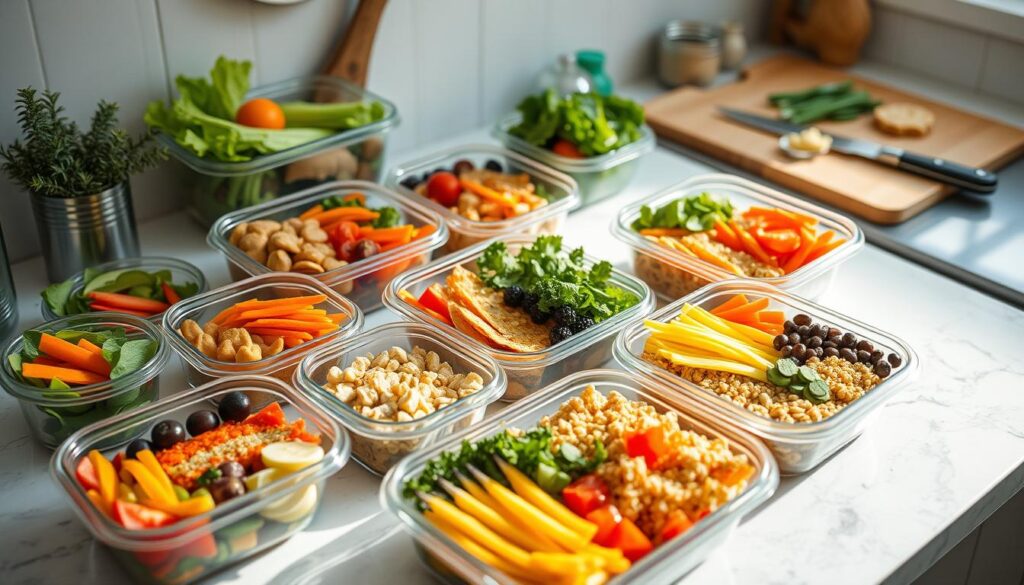
Tracking Progress with a Food Diary
Starting a food diary can really change the game in tracking your progress and eating mindfully. By writing down what you eat, you become more aware of your eating habits and see where you need to get better. Studies show that people who keep a food diary can lose twice as much weight than those who don’t. This simple step can lead to big changes in your diet over time.
Using a food diary can help you with portion control and eating balanced meals. By keeping track of what you eat, you can spot what’s missing nutrition-wise and make smarter food choices. People who track their food are 25% better at sticking to weight loss plans. Writing down what you eat right after you eat it means you’ll remember every bit of food more accurately.
Moreover, writing down your meals makes you more accountable, which can increase your motivation by 40%. This habit helps you see your eating patterns and avoid emotional overeating. In short, a food diary encourages mindful eating and boosts your overall health happiness. When paired with advice from dietitians, it can improve your diet, digestion, and energy, being a valuable tool for your health.
